Friday, March 17, 2006
Æ23, Dium in Macedonia, Gallienus, cf. Sear GIC 4634 (Salonina)
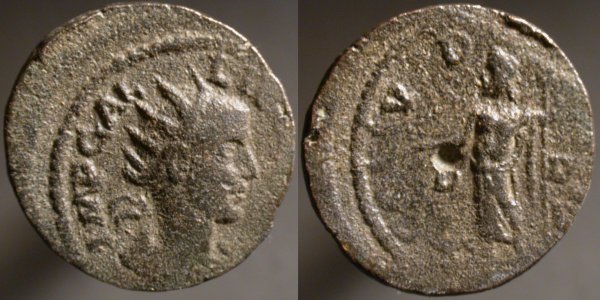
IMP GAL_LIE[NVS AVG], Radiate draped bust right | COL IV[L] D_[IENSIS], Jupiter standing left, holding patera in right hand and long scepter with left, eagle at feet, left. D in left and right fields.
This coin was struck so off-center that, on the upper right side of the coin and around 9:00 on the reverse, beyond the dotted border the edge of the die face can be seen. The Romans, it seems, didn't waste effort making the dies wider than they needed to be, laudibly practical people.
Google helps me not at all in finding Dium in any useful way. This annoys me.
Thursday, March 16, 2006
Billon antoninianus, Gallienus, Mediolanum, Göbl 1036e
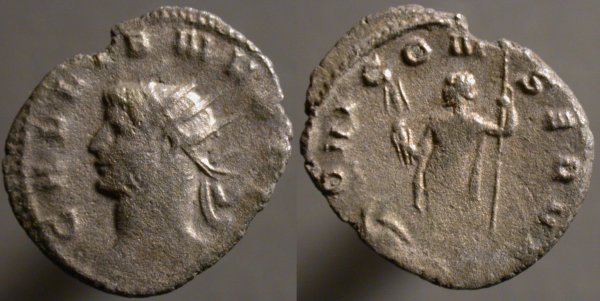
GALLIENVS AVG, Radiate head left | IOVI CONSERVA, Jove standing left, brandisking thunderbolt in right hand and scepter with left. Eagle at feet left.
So very many coins touting VIRTVS the (martial) virtue of the emperor, clearly a very important characteristic for an emperor to be thought to have.
Because, I think, the coins of this family are of unlovely design and of debased metal, the quality of which continued to decline, and because biased histories make Gallienus himself a concupiscent slave to passion, too ready to be lead by his wife, I can easily afford coins of extraordinary rarity, so long as I'm willing to accept that their rarity is only clear when close study distinguishes small details and that, where 1,750 years hasn't granted them great value, neither is it likely that the next few centuries will.
Göbl attests three of these. It's not meant as an estimate of this coin's population, but it's unlikely that there are more than two or three dozen, and it cost no more than a good lunch. Well, a very good lunch, but still.
Wednesday, March 15, 2006
Æ Follis, Maximinus II Daia, Ostia, RIC 92a
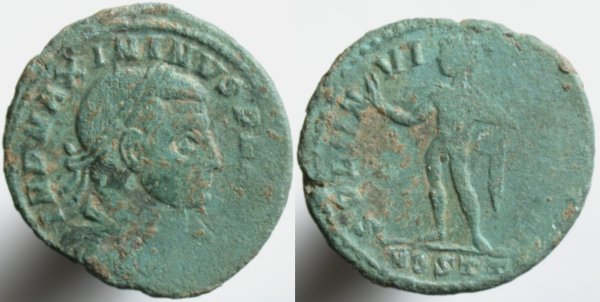
IMP MAXIMINVS P F AVG, Laureate draped cuirassed bust right | SOLI INVICTO COMITI, Sol, standing left. nude except for chlamys hanging behind right. Raising right hand, holding globe in left. MOSTT in exergue.
Carrying on Diocletian's tetrarchy, when he became emperor Galerius made his nephew and adopted son Caius Valerius Galerius Maximinus his protege in the eastern part of the empire.
When the death of Constantius I prompted a struggle over succession that made the brittleness of the tetrarchy apparent, Maximinus received the meaningless new title Filius Augustus ("son of the Augustus") rather than becoming an Augustus as he wanted. By 310, he'd declared himself Augustus,
and soon war was being fought between shifting alliances of the many claimants to control of the empire. In 313, after losing two battles near Tarsus, Maximinus died at his own hand or that of the victors. The failure of the tetrarchy was clear, unable to outlast its author.
While this isn't the best-looking of the few coins I have of Maximinus, it's my favorite, one of the nicest successes I had when I was buying uncleaned ancients. I forgive it its poor strike and the dirt that remained when I decided to stop cleaning before I made things worse.
Tuesday, March 14, 2006
Æ22, Cyzikus in Mysia, Salonina, SNG Copenhagen 142
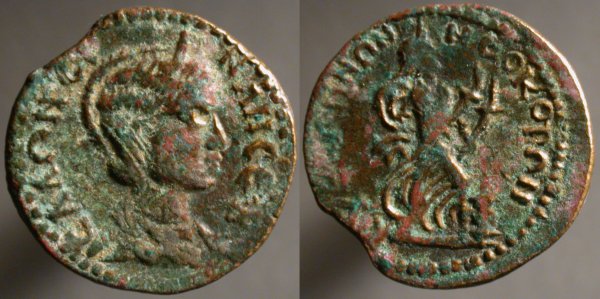
CAΛΩNEI_NAN CEB, Diademed draped bust right | KYZIKHNΩN NEOKOPΩN, Artemis Phosphoros advancing right with a torch in each hand.
Like this 30mm coin of her husband, this smaller coin of Salonina shows Artemis as light-bringer. Artemis had many titles, which may indicate the incorporation of older deities and their characteristics. In this case, Artemis is a light-bringer because she's a moon goddess. I have few coins of Antioch showing Diana, her Roman analogue, carrying a torch.
Monday, March 13, 2006
Billon antoninianus, Gallienus, Antioch, Göbl 1617e
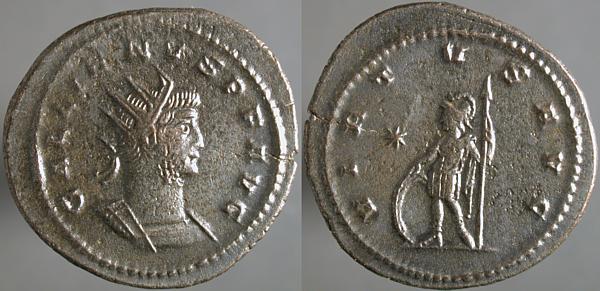
GALLIENVS P F AVG, Radiate cuirassed bust right | VIRTVS AVG, Mars standing left, holding spear right, leaning on shield left. Star in left field.
So very many coins touting VIRTVS the (martial) virtue of the emperor, clearly a very important characteristic for an emperor to be thought to have. A big empire has a long border, and by this time, the Romans had a long border with no lack of enemies along it.

